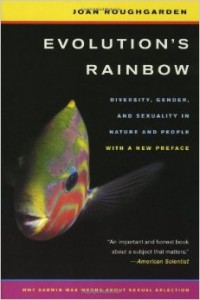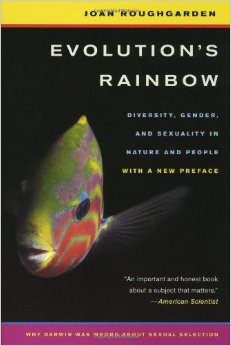 Evolution’s Rainbow: Diversity, Gender,
Evolution’s Rainbow: Diversity, Gender,
and Sexuality in Nature and People
by Joan Roughgarden
University of California Press
472 pages, $27.50
HOW YOU SEE a rainbow depends upon your vantage point. The author of Evolution’s Rainbow is a male-to-female transsexual and a highly respected evolutionary biologist at Stanford University. As it happens, we are well-positioned as reviewers to appreciate as much of the GLBTI spectrum—we use the “I” for “intersexual”—as Roughgarden does: collectively we have lived our lives as male, female, straight, gay, transsexual, and eunuch. We find Roughgarden’s book thorough and nuanced, but we question some of its conclusions.
Anyone looking for evidence that nature accommodates more than just males, females, and heterosexual behavior will find in Evolution’s Rainbow a plethora of supporting examples.
The first and strongest of the book’s three parts is a rich review of same-sex sexual interactions in the animal world. Roughgarden recognizes as gender roles what most biologists would call “morphs” (mature individuals of the same sex that are distinguishable by size, shape, or color). For example, bluegill sunfish, like most animals, have only two sexes (sperm producers and egg producers), but each sex has a large and small morph with different social sexual behaviors. So, according to Roughgarden, bluegill sunfish have four genders.
Roughgarden gives gender diversity abundant attention without subsuming it in the framework of homosexuality. She offers details on sexual anatomy, gender roles, and sexual behavior without resorting to a “gay gene” to account for this diversity. At the heart of her book is the notion that sex and gender diversity is natural and has positive social value. For example, non-breeders can serve in “helper” roles for other members of the group. As for sex, it is Roughgarden’s view that sexual activity is often about establishing and maintaining relationships rather than about reproduction, and she observes a number of species in which sexual behavior serves to establish mutually supportive bonds.
Now for some of our concerns about this book. First, Roughgarden has inconsistent standards for the use of terminology. She chides sociobiologists who use loaded phrases like “the selfish gene” and “sneaker” males, but unabashedly introduces the term “genial gene,” and refers to separated breeding pairs as “divorcing” and “deadbeat” animals. While criticizing others’ use of “sound bites,” she has a penchant for catch phrases, albeit different ones.
Of greater concern, Roughgarden undercuts her scientific credibility with her strident opposition to Darwin’s theory of sexual selection. This theory, which is still held today in more or less its original form, claims that organisms can pass traits on to their descendants based solely on the results of competition for mates, regardless of their direct survival value. Using the classic example of the peacock, natural selection should select against the peacock’s flamboyant tail because it makes the animal susceptible to predators. However, sexual selection adds the idea that the cock’s display appeals to peahens, so the peahens’ propensity to mate with him is enhanced and the fancy tail survives. Roughgarden doesn’t like the sexist implications of this, objecting to the idea that male animals compete for dominance over females and that females choose to mate with the winners. Advocates of sexual selection have argued (hoped?) that females may be attracted to intelligence, but Roughgarden interprets this to mean that females have brains only so they can admire male brains. This biological inequality between the sexes causes Roughgarden to reject sexual selection as “an elite male heterosexist narrative projected onto animals.”
What she offers instead is a theory that subsumes much of the “rainbow” under classical Darwinian natural selection. In her view, same-sex sexual relations are adaptive because they promote friendship and alliances: “[H]omosexuality emerges as a complex social adaptation, a product of positive evolution,” she writes. Her argument rests on a couple of key assumptions. First, homosexuality must be partially heritable (although surely not controlled by a single gene). Next, there has to be some bisexuality in the gay and lesbian community so that carriers of those genes can pass them on to offspring. In this regard Roughgarden cites data from ten years ago that two thirds of lesbians are mothers, and supposedly half or more of gay and bisexual men are fathers. She speculates that “a disadvantage in fertility could be offset by a higher survival rate.” This is a testable hypothesis, but without much supporting data. Even factoring out AIDS, one is hard pressed to show that gays and lesbians have improved survivorship—that is, do their kids live longer? Perhaps, but that’s yet to be investigated.
One also fears that Roughgarden will be quoted out of context by creationists eager to discredit Darwin any way they can. Consider the following from Evolution’s Rainbow: “[T]he facts of nature falsify Darwin’s … theory.” “Darwin is incorrect in almost all details.” “Diversity in gender expression and sexuality undercuts the foundation of Darwin’s theory.” True, she’s only talking about Darwin’s theory of sexual selection, not his theory of natural selection, but the chatter on a website called “The Evangelical Outpost” suggests that such misinterpretation has already begun.
Evolution’s Rainbow shifts to human societies in the third and final part, a meandering cross-cultural exploration of gender and sexuality. Many examples are touched upon, such as the male-to-female Hijra in modern India, the eunuchs in the Roman Empire, the intersexed Guevedoche in the Dominican Republic, and the Tombois in Indonesia. While informative, this part doesn’t directly support Roughgarden’s biological argument or offer a thesis of its own. If this sprawling essay on culture has any effect on the vast list of animal and human biological diversity that precedes it, it is at least a good illustration of Roughgarden’s claim that gender and sexuality are enormously complex.
Despite Roughgarden’s celebration of gender diversity within our own species, there are some glaring weaknesses in her historical review. We were surprised, for example, that she lumped eunuchs together with transgendered people and gave them such superficial treatment. (“Early transgender people in Europe were classed as eunuchs.”) She also ignores the brutality of castration associated with slavery. She attempts to shoehorn the practice into an adaptive Darwinian model when she writes, “The parents of eunuch slaves presumably benefited from the sale of their child into slavery, and perhaps this enabled them to raise additional children.” But what about children who were kidnapped for the slave trade against their parents’ knowledge or wishes? Roughgarden goes too far with adaptationist story-telling when she tries to put a positive spin on the production of eunuch slaves.
Actual rainbows are a delight to behold but are transient optical illusions. Many parts of Evolution’s Rainbow are a delight to read, but whether any of these adaptationist arguments have enduring significance for GLBTI acceptance remains to be seen.
Tucker Lieberman has contributed articles on gay spirituality to White Crane Journal and Transgender Tapestry.
Richard Wassersug is a professor in the department of Anatomy and Neurobiology at Dalhousie University in Halifax, Nova Scotia.






